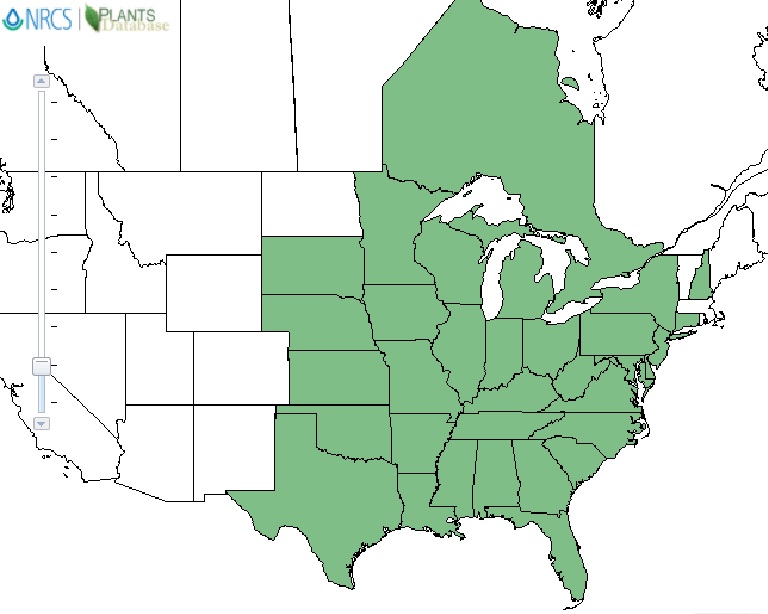Smilax hispida
| Smilax hispida | |
|---|---|

| |
| Photo by John Hilty hosted at IllinoisWildflowers.info | |
| Scientific classification | |
| Kingdom: | Plantae |
| Division: | Magnoliophyta - Flowering plants |
| Class: | Liliopsida - Moncots |
| Order: | Liliales |
| Family: | Smilacaceae |
| Genus: | Smilax |
| Species: | S. hispida |
| Binomial name | |
| Smilax hispida Rafinesque | |

| |
| Natural range of Smilax hispida from Weakley. Natural range of Acer rubrum from USDA NRCS Plants Database. | |
Common Name: bristly greenbriar[1][2]
Contents
Taxonomic Notes
Synonym: S. tamnoides; S. tamnoides 'var. hispida (Muhlenberg) Fernald
Varieties: S. hispida var. hispida; S. hispida var. australis
Description
Smilax hispida is a monoecious perennial that grows as a shrub or vine.[2] As a vine, it frequently climbs 30-45 ft (9.1-13.7 m) into trees and has internodes on the main stem 4-10 in (10.2-25.4 cm) apart. Stems are usually very prickly.[3] In central eastern Illinois, it averages 13 stems and its seeds have a mean mass of 23.690 mg.[4]
Distribution
This species ranges from Connecticut, New York, Minnesota, and Nebraska south to Texas and southern Florida.[1][2][5]
Ecology
Habitat
S. hispida has been found in river bluffs, wooded hammocks, floodplains, calcareous woodland bluffs, mixed pine forests, wooded ravines, and trees.[6] It is also found in disturbed areas including along fences and field margins.[6]
Associated species: Pinus palustris, Quercus hemisphaerica, Callicarpa americana, Smilax auriculata, Smilax hispida, Cornus florida, and Morella cerifera.[6]
Within southern Ohio burned oak forests, the mean frequency ranged between 5.2-6.7% of plots between 1995 and 1999.[7]
Fire ecology
Populations of Smilax hispida have been known to persist through repeated annual burns on the Pebble Hill plantation in north Florida[8] and Wade Tract of south Georgia,[9] but both solitary (burned once) and recurring (biennial) burns reduced the average percent cover of S. hispida on a red and white pine mixed plantation in Kalamazoo County, Michigan during 1991-1995.[10]
Conservation, cultivation, and restoration
Cultural use
There are many species of Smilax and it is thought they can all be used in similar ways. Historically, the roots were harvested and prepared in a red flour or a thick jelly that could be used in candies and sweet drinks. Our first known written account of using the plant roots to make this jelly is from the journal of Captain John Smith in 1626. Other travelers throughout US history have made note of the uses of Smilax plants. We know the flour was used in breads and soups, and that a drink very similar to Sarsaparilla could be prepared.[11]
Photo Gallery
References and notes
- ↑ 1.0 1.1 Weakley AS (2015) Flora of the Southern and Mid-Atlantic States. Chapel Hill, NC: University of North Carolina Herbarium.
- ↑ 2.0 2.1 2.2 USDA NRCS (2016) The PLANTS Database (http://plants.usda.gov, 23 January 2018). National Plant Data Team, Greensboro, NC 27401-4901 USA.
- ↑ Schaffner JH (1931) Characteristic examples of accumulative progressive evolutionary movements: Studies in determinate evolution, V. Ohio Journal of Science 31(5):346-367.
- ↑ Michaels HJ, Benner B, Hartgerink AP, Lee TD, Rice S, Willson MF, Bertin RI (1988) Seed size variation: magnitude, distribution, and ecological correlates. Evolutionary Ecology 2:157-166.
- ↑ Zhao Y, Qi Z, Ma W, Dai Q, Li P, Cameron KM, Lee J, Xiang Q, Fu C (2013) Comparative phylogeography of Smilax hispida group (Smilacaceae) in eastern Asia and North America - Implications for allopatric speciation, causes of diversity disparity, and origins of temperate elements in Mexico. Molecular Phylogenetics and Evolution 68:300-311.
- ↑ 6.0 6.1 6.2 Florida State University Herbarium Database. URL: http://herbarium.bio.fsu.edu. Last accessed: June 2021. Collectors: R.K. Godfrey, R. Kral, Richard S. Mitchell, and William Platt. States and counties: Florida: Gadsden, Jackson, Jefferson, Leon, and Volusia. Georgia: Thomas.
- ↑ Hutchinson T (2005) Fire and the herbaceous layer of eastern oak forests. Proceedings of Fire in Eastern Oak Forests: Delivering science to land managers. Nov 15-17, 2005, Columbus, OH. USDA Forest Service, General Technical Report NRS-P-1, pp. 136-149
- ↑ Robertson, K.M. Unpublished data collected from Pebble Hill Fire Plots, Pebble Hill Plantation, Thomasville, Georgia.
- ↑ Platt, W.J., R. Carter, G. Nelson, W. Baker, S. Hermann, J. Kane, L. Anderson, M. Smith, K. Robertson. 2021. Unpublished species list of Wade Tract old-growth longleaf pine savanna, Thomasville, Georgia.
- ↑ Neumann DD, Dickmann DI (2001) Surface burning in a mature stand of Pinus resinosa and Pinus strobus in Michigan: effects on understory vegetation. International Journal of Wildland Fire 10:91-101.
- ↑ Fernald, et al. 1958. Edible Plants of Eastern North America. Harper and Row Publishers, New York.